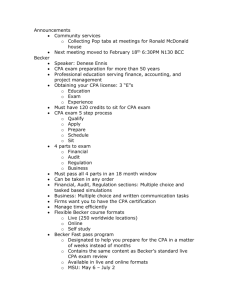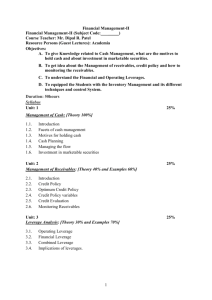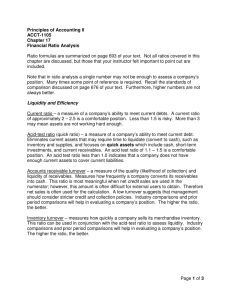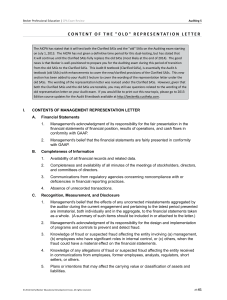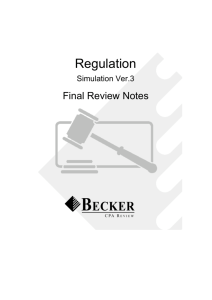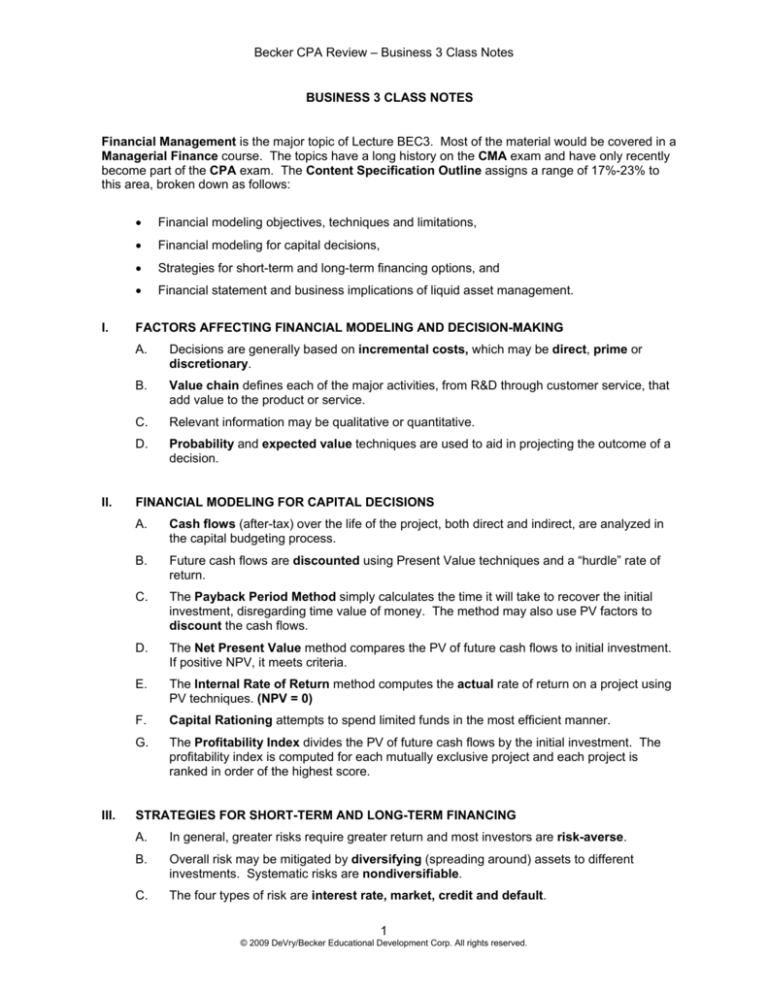
Becker CPA Review – Business 3 Class Notes
BUSINESS 3 CLASS NOTES
Financial Management is the major topic of Lecture BEC3. Most of the material would be covered in a
Managerial Finance course. The topics have a long history on the CMA exam and have only recently
become part of the CPA exam. The Content Specification Outline assigns a range of 17%-23% to
this area, broken down as follows:
I.
II.
III.
•
Financial modeling objectives, techniques and limitations,
•
Financial modeling for capital decisions,
•
Strategies for short-term and long-term financing options, and
•
Financial statement and business implications of liquid asset management.
FACTORS AFFECTING FINANCIAL MODELING AND DECISION-MAKING
A.
Decisions are generally based on incremental costs, which may be direct, prime or
discretionary.
B.
Value chain defines each of the major activities, from R&D through customer service, that
add value to the product or service.
C.
Relevant information may be qualitative or quantitative.
D.
Probability and expected value techniques are used to aid in projecting the outcome of a
decision.
FINANCIAL MODELING FOR CAPITAL DECISIONS
A.
Cash flows (after-tax) over the life of the project, both direct and indirect, are analyzed in
the capital budgeting process.
B.
Future cash flows are discounted using Present Value techniques and a “hurdle” rate of
return.
C.
The Payback Period Method simply calculates the time it will take to recover the initial
investment, disregarding time value of money. The method may also use PV factors to
discount the cash flows.
D.
The Net Present Value method compares the PV of future cash flows to initial investment.
If positive NPV, it meets criteria.
E.
The Internal Rate of Return method computes the actual rate of return on a project using
PV techniques. (NPV = 0)
F.
Capital Rationing attempts to spend limited funds in the most efficient manner.
G.
The Profitability Index divides the PV of future cash flows by the initial investment. The
profitability index is computed for each mutually exclusive project and each project is
ranked in order of the highest score.
STRATEGIES FOR SHORT-TERM AND LONG-TERM FINANCING
A.
In general, greater risks require greater return and most investors are risk-averse.
B.
Overall risk may be mitigated by diversifying (spreading around) assets to different
investments. Systematic risks are nondiversifiable.
C.
The four types of risk are interest rate, market, credit and default.
1
© 2009 DeVry/Becker Educational Development Corp. All rights reserved.
Becker CPA Review – Business 3 Class Notes
IV.
D.
The effective interest rate is the actual finance charge for borrowing and will generally be
higher than the stated rate.
E.
Operating leverage measures the effect on a firm’s profitability caused by a change in
sales. Firms that rely more heavily on fixed costs as opposed to variable will have higher
leverage. High leverage means greater return on the up side with higher risk on the down
side.
F.
Financial leverage is the degree to which a firm uses debt to finance operations. Again,
high leverage means high risk/return.
G.
A firm’s Weighted-Average Cost of Capital (WACC) is calculated using the weighted
proportion of the entity’s cost of debt (kdx), preferred stock (kps) and equity (kre). Equity
cost may be the cost of R/E or issuing new common stock. WACC is often used as a
“hurdle” rate in capital investment decisions.
H.
The Optimal Capital Structure is the one that produces the lowest WACC.
I.
The cost of retained earnings can be calculated using the Capital Asset Pricing Model
(CAPM), Discounted Cash Flow (DCF) or Bond Yield Plus Risk Premium (BYRP) method.
J.
Short-term financing, because it generally carries lower interest rates than long-term,
offers the advantages of increased liquidity and lower costs. Disadvantages are increased
interest rate risk and increased credit risk, or inability to re-borrow in the future.
K.
In addition to long-term debt (bonds and mortgages) and equity financing, other options
may be working capital maturity matching, letters of credit, lines of credit and leasing.
L.
Return on Investment (ROI) measures an entity’s percentage return on their investment in
capital assets. As with other measures, it should not be relied upon as the sole criteria.
M.
A Balanced Scorecard identifies measures related to multiple dimensions of a business
(FICA).
N.
Residual Income represents the excess of an entity’s net income over its required return
based on the hurdle rate and net assets.
O.
Other methods for long-term debt analysis relate Debt to Total Capital. Assets or Equity.
FINANCIAL STATEMENT AND BUSINESS IMPLICATIONS OF LIQUID ASSET
MANAGEMENT
A.
Working Capital Management involves managing current assets and current liabilities so
that a company can meet its current obligations in an efficient manner. The Current and
Acid-Test Ratios are used in WC analysis.
B.
Motives for holding cash are Transaction, Speculation and Precautionary. The Cash
Conversion Cycle measures the time from cash outlay to cash collection. This time period
can be shortened by reducing inventories, collecting receivables more quickly or
deferring remittances on payables for a longer period.
C.
Effective cash management synchronizes inflows and outflows. Float, overdraft
protection and compensating balances are additional tools for cash management.
D.
Marketable Securities with short-term maturities, such as T-bills or CD’s, provide a return
on cash not currently being used for operations.
E.
As with any investment, marketable securities carry some level of Maturity, Inflation,
Liquidity and Default Risk Premium.
2
© 2009 DeVry/Becker Educational Development Corp. All rights reserved.
Becker CPA Review – Business 3 Class Notes
F.
Accounts Receivable Management involves effectively balancing credit and collection
policies to optimize the average collection period and number of days’ sales in
receivables. A company can also factor (sell) its receivables to get cash more quickly;
however, this is generally costly and should only be used if no other alternatives are
available.
G.
Trade credit is the primary source of short-term credit for most firms. If discounts are
available for prompt payment, it is generally to the advantage of the entity to take them
because of their rate of return.
H.
Inventory Management attempts to balance the costs of carrying inventory against the
costs of “stocking out.” Inventory Turnover and the number of days’ sales in inventory
are two key ratios used in analysis. Safety stock, economic order point (EOP) and
economic order quantity (EOQ) are tools used to control inventory quantities.
Technology has made significant improvements in inventory control possible. Materials
Requirement Planning (MRP), Just-in-Time and Kanban are some of these
contemporary techniques.
I.
Institutional short-term credit arrangements will usually contain many covenants and rate
provisions (fixed vs. variable). In general, these vary with the credit-worthiness of the
borrower and must be disclosed in the entity’s financial statements.
In addition to the detailed material covered in the text, there are four appendices and a terminology list
to expand upon the lecture materials. The appendices are:
I.
Accounting Rate of Return (ARR),
II.
Comparison of CAPM, DCF, and BYRP to compute cost of R/E,
III.
Explanation of CAPM, Beta coefficient and Securities Market Line and
IV.
Applying Beta and Risk Analysis to Capital Investment.
While working the homework and supplemental questions, keep in mind that many of them were taken
from prior CMA exams. Some of the MCs use one common fact situation to generate three or four
questions and have a high degree of difficulty. It is unlikely that your exam will contain such questions
due to the limitations of the CBT approach and the brief time allocated to each question.
3
© 2009 DeVry/Becker Educational Development Corp. All rights reserved.

